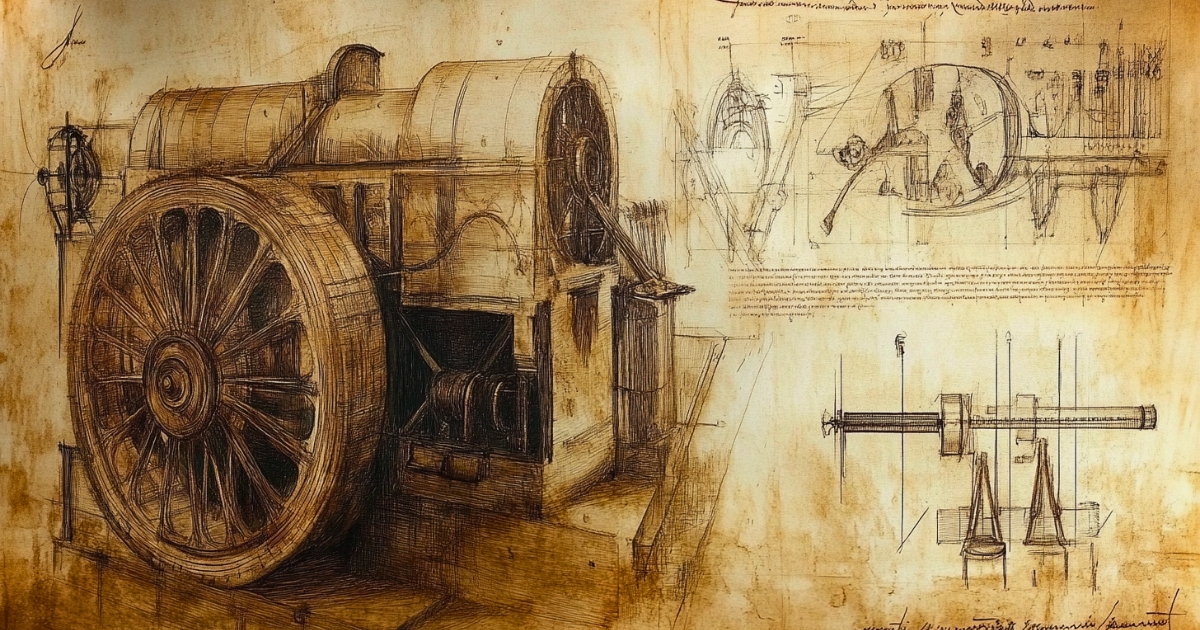Leonardo da Vinci, who flourished from the late 15th to early 16th century, was not only a representative artist of the Renaissance but also a scientist. His numerous sketches and manuscripts are not only valuable as works of art but also contain a treasure trove of innovative invention ideas for their time. However, many of these could not be realized due to the technological limitations of the era. This article focuses on the inventions that da Vinci conceptualized but failed to bring to fruition, exploring how modern technology has brought them to life.
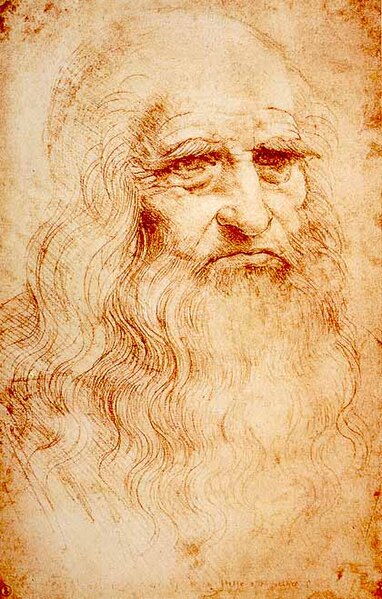
Self-portrait of Leonardo da Vinci (c. 1512). His insightful gaze is impressive, reflecting his roles as both a Renaissance artist and scientist. By Leonardo da Vinci
Da Vinci’s Life and Historical Context
Leonardo da Vinci was born in 1452 in the village of Vinci, Italy. He lived during the height of the Renaissance, an era when the boundaries between art and science were blurred. While da Vinci devoted himself to creating artworks such as paintings and sculptures, he also had interests in a wide range of fields including anatomy, engineering, and astronomy, conducting his own research.
His intellectual curiosity knew no bounds, and he was highly advanced for his time in adopting a scientific approach based on observation and experimentation. Da Vinci sought to understand the laws of nature and apply them to create new inventions. However, the technological standards of the time made it impossible to realize many of his ideas.
Da Vinci’s Invention Concepts
Da Vinci’s manuscripts contain numerous sketches and blueprints of inventions. Among these were precursors to technologies that would be realized centuries later. Here, we introduce the main inventions he conceptualized and their modern interpretations.
1. Flying Machine
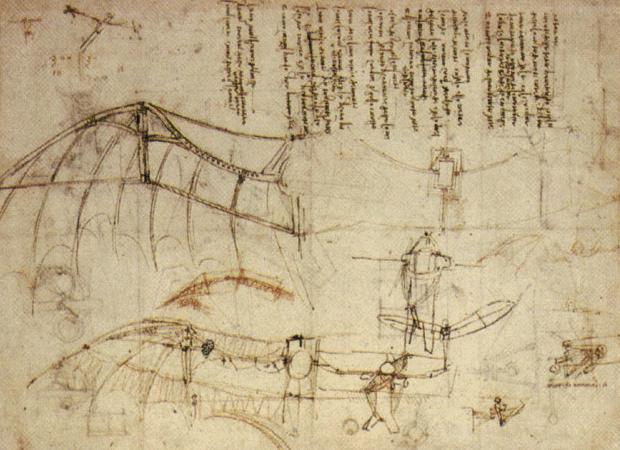
Da Vinci’s design for a flying machine (c. 1488). The concept of the ‘ornithopter’, modeled after bird wings, is detailed. By Leonardo da Vinci
Da Vinci had a strong interest in the flying mechanism of birds and devised a device for human flight. His most famous aircraft design was called the “ornithopter,” a flapping-wing aircraft modeled after bird wings.
Da Vinci conducted detailed observations and analyses of wing structure and aerodynamics, reflecting these insights in his design. However, it was impossible to generate the force needed to move large wings by human power, and the ornithopter never actually flew.
Modern Interpretation:
Da Vinci’s ornithopter design can be seen as a precursor to the fixed-wing aircraft realized in the early 20th century. His research on aerodynamics greatly influenced the development of later aeronautical engineering. Today, small models based on da Vinci’s blueprints have been created and actual flight experiments conducted. These experiments have proven the validity of da Vinci’s design and reevaluated his foresight.
2. Submarine
Da Vinci was also interested in underwater exploration and conceived the idea of a submarine. His submarine design featured a cylindrical wooden hull with leather seals to maintain water tightness. He also devised breathing apparatus for use during dives and weapon systems for attacking enemy ships.
However, it is said that da Vinci intentionally concealed parts of the design, fearing that his invention might be used for war. As a result, his submarine remained a concept on paper.
Modern Interpretation:
Da Vinci’s submarine design was surprisingly close to the basic principles of modern submarines. His design shows the embryonic stages of modern submarine technology, including hull structures to withstand water pressure, buoyancy adjustment mechanisms, and propulsion systems.
Currently, experimental submarines based on da Vinci’s design are being built and their performance verified. These experiments are proving that da Vinci’s concept was indeed feasible.
3. Automated Doll (Robot)
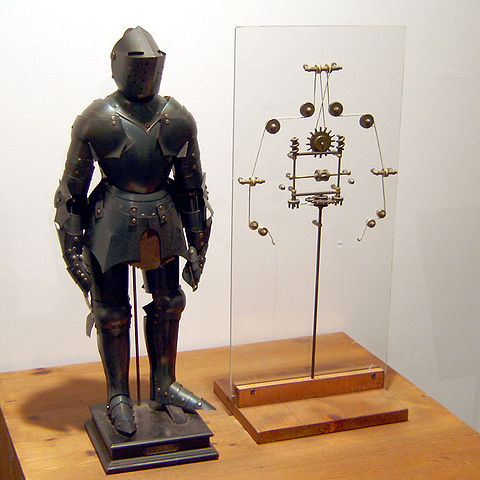
A model of the ‘mechanical knight’ based on Leonardo da Vinci’s drawings. The design mimics human movement through complex gear and pulley systems. Photo by Erik Möller. Leonardo da Vinci. Mensch – Erfinder – Genie exhibit, Berlin 2005.
Da Vinci was also interested in mechanical devices that mimicked human movement. His designed “mechanical knight” was a humanoid device capable of sitting up, standing, and moving its jaw. This device was designed to operate with an intricate mechanism combining gears, pulleys, and cables.
At the time, such automated dolls were mainly used for aristocratic entertainment and court events, but da Vinci’s design stood out for its complexity and precision.
Modern Interpretation:
Da Vinci’s mechanical knight can be considered a precursor to modern robotics. His design features mechanisms that mimic the human musculoskeletal system, which aligns with the design philosophy of modern humanoid robots.
In recent years, replicas of the mechanical knight that actually move have been created based on da Vinci’s blueprints. These replicas demonstrate da Vinci’s deep understanding of mechanical engineering and the feasibility of his designs.
4. Automobile
Da Vinci also envisioned self-propelled vehicles that didn’t rely on human or horse power. His designed “self-propelled cart” was a three-wheeled vehicle that moved using a spring mechanism and gear system. This vehicle was designed to self-propel for a certain distance by winding up the spring in advance.
Moreover, this self-propelled cart incorporated a steering mechanism that can be seen as the prototype of modern car steering systems.
Modern Interpretation:
Da Vinci’s self-propelled cart design predated the invention of the internal combustion engine by several hundred years. His design already included basic elements of modern automotive technology, such as power transmission systems and steering mechanisms.
Currently, working models of self-propelled carts are being created based on da Vinci’s blueprints. These models serve as evidence of how advanced his mechanical engineering knowledge was.
5. Parachute
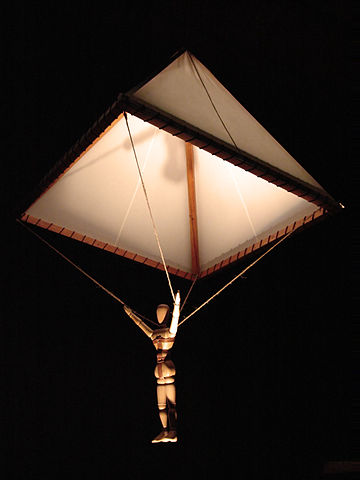
A model of da Vinci’s parachute. While its pyramidal shape differs from modern parachutes, the basic principle of using air resistance is the same. Nevit Dilmen, CC BY-SA 3.0, via Wikimedia Commons
Da Vinci devised a parachute as a device for safely descending from high places. His designed parachute had a pyramidal shape with linen cloth stretched over a wooden frame. While this shape differs from modern parachutes, the basic principle of using air resistance to control falling speed was the same.
Regarding this parachute, da Vinci wrote, “If a man have a tent made of linen of which the apertures have all been stopped up, and it be twelve braccia across and twelve in depth, he will be able to throw himself down from any great height without suffering any injury.”
Modern Interpretation:
While the shape of da Vinci’s parachute design differs from modern ones, its basic function is the same. Interestingly, in 2000, British skydiver Adrian Nicholas created a parachute based on da Vinci’s design and successfully jumped from a height of 2,400 meters.
This test proved that da Vinci’s parachute design was practical. With modern materials and technology, his design could be further improved and potentially become an even more efficient parachute.
Da Vinci’s Legacy and Influence on the Modern World
Many of Leonardo da Vinci’s invention concepts were not realized during his lifetime. However, his ideas and blueprints greatly influenced later scientists and inventors. Da Vinci’s manuscripts began to attract the attention of researchers gradually from the 17th century onwards, with full-scale research being conducted from the late 19th to the 20th century.
Today, many of da Vinci’s inventions are being recreated using computer graphics and 3D printing technology. Through these recreation efforts, the precision and feasibility of da Vinci’s designs are being reevaluated.
Furthermore, da Vinci’s interdisciplinary approach has greatly influenced modern STEM (Science, Technology, Engineering, and Mathematics) education. His observational skills, creativity, and ability to integrate knowledge from different fields are relevant to today’s innovative technology development.
Conclusion
Leonardo da Vinci’s invention concepts are being realized through modern technology after more than 500 years. His foresight and creativity continue to amaze us and provide inspiration.
Da Vinci’s achievements teach us the importance of merging science and art, taking an experimental approach based on observation, and thinking freely without being bound by existing concepts. It can be said that the development of modern science and technology stands on the contributions of pioneers like da Vinci.
The vast manuscripts and blueprints he left behind are still being deciphered by researchers, with new discoveries continuing to emerge. The recreation and verification of da Vinci’s inventions are not just of historical interest but are bringing new perspectives and possibilities to modern technology development.
Leonardo da Vinci’s genius concepts continue to teach us the importance of creativity and innovation, transcending 500 years of time. His legacy will continue to provide significant insights for the development of future science and technology.
